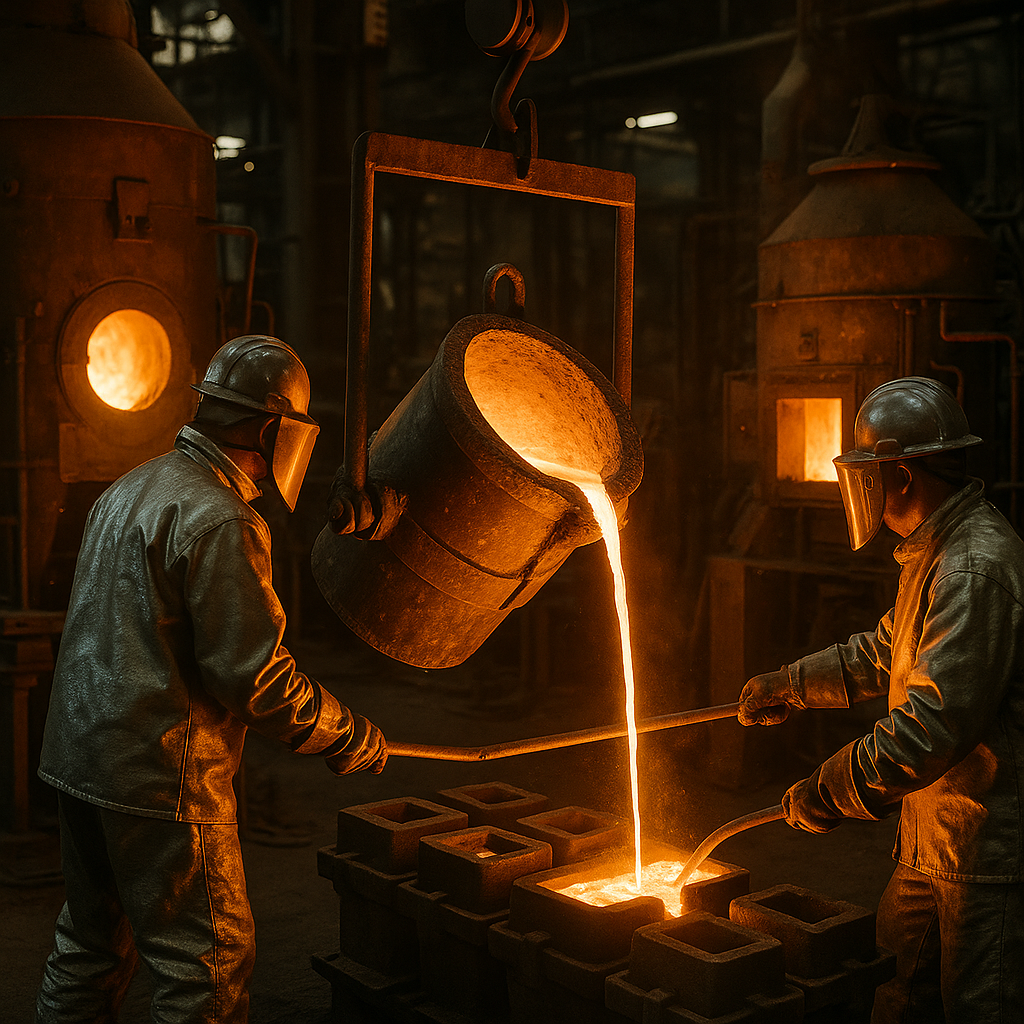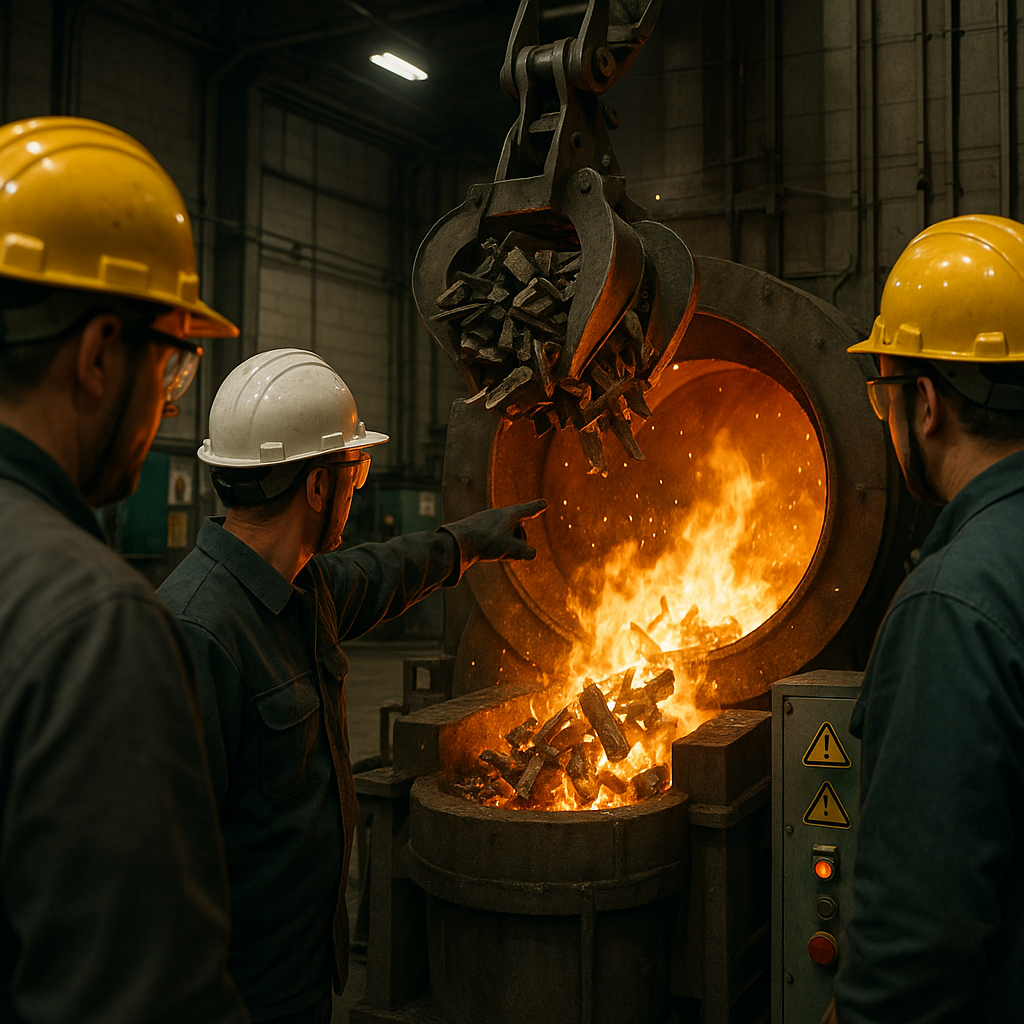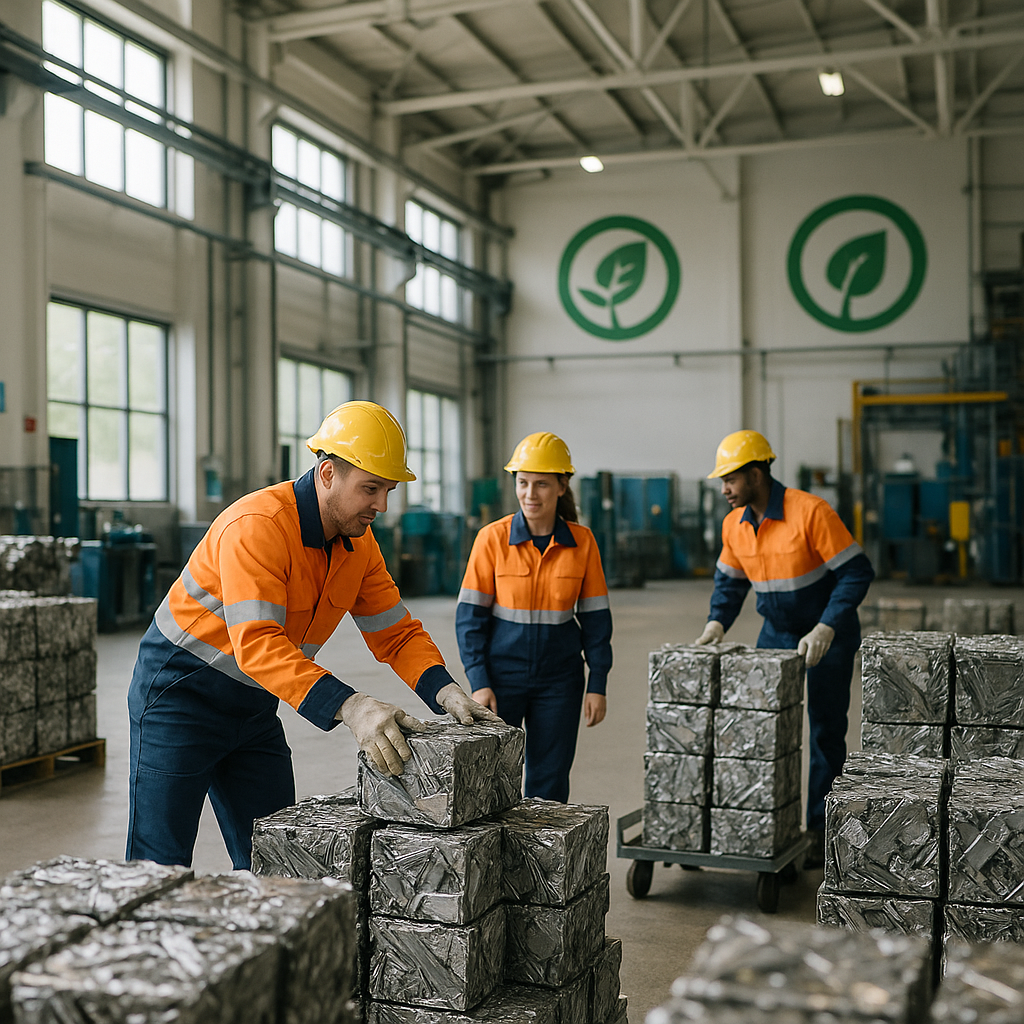5901 Botham Jean Blvd, Dallas, TX 75215
Smelting Recycled Metals: Processes, Benefits, and the Future of Sustainable Recycling
September 30, 2025Smelting is one of humanity’s oldest industrial processes, with a history stretching back 6,000 years. This ancient technique transformed early civilizations by enabling the creation of tools, weapons, and structures from metals.
At its core, smelting recycled metals involves applying heat to melt solid scrap metal, transforming it into a liquid state that can be molded into new products. The process requires specialized furnaces that reach specific temperatures based on the metal being processed. For example, aluminum melts at around 660°C, while steel requires approximately 1370°C.
The choice of smelting method depends heavily on the metal’s composition and its fluidity when melted. Different metals and alloys require specific techniques to effectively separate impurities and achieve the desired properties in the final product. This science-based approach ensures that recycled metals maintain their structural integrity and usefulness.
What Are the Main Types of Metal Smelting Processes?

Metal smelting transforms scrap metal into valuable new resources through various specialized processes. Each method offers unique advantages for different types of metals and desired outcomes in the recycling industry. Understanding these processes helps optimize metal recovery and ensure high-quality recycled materials.
Sand Smelting
Sand smelting uses silica-based molds to cast both ferrous and non-ferrous metal alloys. The process involves pouring molten metal into a two-part sand mold, allowing it to cool, and then removing excess material to create the final product.
This versatile technique is widely used in recycling operations for producing large metal components like engine blocks and cylinder heads. It remains popular due to its relatively low cost and ability to handle metals with high melting points such as steel and titanium.
However, sand smelting produces parts with rougher surface finishes and lower precision compared to other methods. This limitation must be considered when determining if this process is suitable for specific recycling applications.
Centrifugal Smelting
Centrifugal smelting pours molten metal into preheated rotating molds. The centrifugal force distributes the liquid metal at high pressure inside the mold, creating uniform, dense parts with minimal defects.
This process comes in three variations:
- True centrifugal smelting – Uses continuous rotation to force metal against mold walls
- Semi-centrifugal smelting – Fills the entire mold using a trough system
- Vertical centrifugal smelting – Uses directional molding techniques
Centrifugal smelting excels in recycling operations that need high-density products with few imperfections. It delivers better yield with less scrap waste than other methods, making it valuable for producing barrel-shaped and composite metal parts.
Die Smelting
Die smelting injects molten metal at high pressure into reusable molds. This process maintains high pressure during injection to prevent premature hardening, then removes and finishes the parts to eliminate excess material.
Die smelting works particularly well for recycling zinc, tin, copper, and aluminum. The process offers two pressure variations:
- Low-pressure smelting – Used for larger, simpler components
- High-pressure smelting – Creates complex parts in large quantities
The precision and dimensional accuracy of die smelting reduce the need for additional machining. This efficiency makes the process valuable for recycling operations producing high volumes of complex metal parts, despite relatively high tool costs.
Vacuum Smelting
Vacuum smelting pours liquid metal into molds inside vacuum chambers to eliminate bubbles and air pockets. By removing air from the mold cavity, this process prevents gases from becoming trapped during metal injection.
The metal solidifies in a controlled heating chamber before removal from the mold. This specialized technique produces exceptionally high-quality recycled metal products for demanding industries including automotive, aerospace, and electronics.
Vacuum smelting significantly reduces porosity and improves the mechanical properties of recycled metals. It excels at producing thin-walled parts and enables subsequent welding and thermal treatments. However, the process involves higher costs and specialized equipment.
Investment Smelting
Investment smelting creates disposable ceramic molds around wax patterns. After removing the wax, molten metal fills the mold to create precisely shaped metal parts. This method is particularly useful for recycling metals into complex components like gears, machinery parts, and specialty items.
The process delivers exceptional results for recycling operations requiring parts with thin walls, high surface quality, and complex geometries. It handles challenging alloys like stainless steel and creates parts with precise 90-degree angles.
While investment smelting produces extremely high-quality recycled metal products, it requires more labor and has a longer production cycle than other methods. Each casting cycle needs a new wax pattern, increasing costs for short production runs.
| Process | Applications | Advantages |
|---|---|---|
| Sand Smelting | Engine blocks, cylinder heads | Low cost, suitable for high melting point metals |
| Centrifugal Smelting | Barrel-shaped and composite parts | High density, better yield, fewer defects |
| Die Smelting | Zinc, tin, copper, and aluminum parts | High precision, dimensional accuracy, less need for machining |
| Vacuum Smelting | Automotive, aerospace, electronics | Reduces porosity, improves mechanical properties |
| Investment Smelting | Gears, machinery parts, specialty items | High surface quality, precise geometries |
How Does the Recycled Metal Smelting Process Work?

The recycling and smelting of metals transform waste into valuable resources through a systematic, multi-stage process. Each stage plays a crucial role in maintaining the recycled product’s quality while minimizing environmental impact.
Collection and Sorting
The process starts with the collection of metals from industrial, commercial, and residential sources. Scrap yards and recycling centers gather various metals, preventing them from ending up in landfills. Once collected, the metals undergo thorough sorting.
Sorting techniques separate ferrous metals (containing iron) from non-ferrous metals using specialized equipment. Magnetic separators extract iron and steel, while eddy current separators identify and sort non-ferrous metals like aluminum and copper. This separation is vital to maintaining the final product’s purity.
Grading and Inspection
After sorting, metals are graded based on type, quality, and purity. This step ensures the recycled materials meet specific industry standards. Trained personnel and automated systems evaluate the metal’s composition to determine its value and best recycling path.
Materials are also inspected for contaminants like paint, oil, or other substances that could compromise the recycling process. Any foreign materials must be removed to maintain the final product’s integrity.
Processing and Shredding
The sorted metals move to processing stations where they are prepared for melting. Hydraulic machinery crushes larger pieces into manageable sizes. Shredders then further reduce the metal, creating small fragments with increased surface area.
Shredding serves several purposes: it makes the metals easier to handle and transport and significantly reduces the energy needed for melting by creating uniform pieces that heat evenly. The increased surface area allows for more efficient melting when the metal reaches the furnace.
Melting in Specialized Furnaces
The core of the smelting process occurs in specialized furnaces designed for specific metals. Each metal requires particular temperature settings and furnace conditions based on its melting point. Steel melts at approximately 1370°C (2500°F), while aluminum liquefies at a much lower 660°C (1220°F).
Furnace types vary by metal. Steel typically melts in electric arc or blast furnaces, while non-ferrous metals like aluminum and copper use reverberatory or rotary furnaces. These environments ensure optimal melting conditions while controlling energy consumption.
Purification
Once melted, the liquid metal undergoes purification to remove remaining impurities. Techniques like fluxing bind with impurities to create removable slag, while electrolysis uses electrical current to separate impurities from the metal.
This decontamination stage is essential for ensuring the recycled metal maintains its structural integrity and meets quality standards. The cleaner the melted metal, the stronger and more reliable the final product.
Solidification and Manufacturing
After purification, the molten metal cools and solidifies into forms suitable for manufacturing. Typically, the liquid metal pours into molds to create ingots, bars, or billets. These standardized shapes facilitate transportation and further processing.
The solidified metal then ships to manufacturing facilities where it is transformed into new products. From construction materials to automotive parts, recycled metal finds applications across numerous industries, completing the recycling loop.
| Metal | Melting Point (°C) | Melting Point (°F) | Furnace Type |
|---|---|---|---|
| Aluminum | 660.32 | 1220.58 | Reverberatory, Rotary |
| Steel | 1425-1540 | 2600-2800 | Electric Arc, Induction |
| Copper | 1084.62 | 1984.32 | Reverberatory, Rotary |
| Lead | 327.5 | 621 | Rotary |
| Iron | 1538 | 2800 | Electric Arc |
Benefits of the Metal Smelting Process
This comprehensive smelting process delivers significant environmental and economic benefits. Recycling one ton of steel conserves approximately 2,500 pounds of iron ore and 1,400 pounds of coal. Aluminum recycling uses 95% less energy than producing new aluminum from raw materials.
The smelting process also reduces mining impacts, decreases landfill waste, and lowers greenhouse gas emissions. As technologies improve, the process becomes increasingly efficient, making metal recycling one of the most successful examples of a circular economy.
What Are the Benefits of Smelting Recycled Metals?
Conservation of Natural Resources
Smelting recycled metals provides substantial environmental benefits by reducing our reliance on raw material extraction. By recycling and smelting metals instead of mining virgin ore, we preserve critical natural resources, an effort crucial given the finite nature of metal ores in the earth’s crust.
Mining operations often result in habitat destruction, soil erosion, and ecosystem damage. Utilizing recycled metals decreases the need for these harmful extraction processes. For instance, recycling one ton of steel conserves around 1.4 tonnes of iron ore, 0.8 tonnes of coal, and 0.3 tonnes of limestone.
The impact of metal recycling on resource conservation is impressive. Approximately 70% of all steel ever produced is still in use today, while 75% of all aluminum ever manufactured continues to circulate in our economy. This illustrates the effectiveness of metal recycling in keeping valuable materials in productive use.
Energy Efficiency and Reduced Emissions
The energy savings from smelting recycled metals versus processing virgin materials are significant. Recycling aluminum saves up to 95% of the energy required for primary production from bauxite ore. Steel recycling reduces energy consumption by 60-75% compared to manufacturing from raw materials.
These energy reductions directly lead to substantial cuts in greenhouse gas emissions. Using steel scrap instead of virgin ore reduces CO2 emissions by 58%. The impact is even more notable with aluminum, where using recycled material can cut carbon emissions by 92% compared to primary aluminum production.
The pollution reduction extends beyond carbon emissions. Creating new products with recycled steel reduces air pollution by 86%, water use by 40%, and water pollution by 76%. These figures underscore how metal recycling contributes to cleaner air and water resources.
Economic Benefits and Market Stability
Smelting recycled metals offers significant economic benefits alongside environmental advantages. The recycling industry generates billions of dollars annually, supporting numerous jobs in collection, processing, and manufacturing across a wide range of skills and education levels, providing diverse employment opportunities.
Manufacturers benefit from cost reductions when using recycled metals, which can result in more affordable products for consumers. Additionally, recycled metals help mitigate price volatility commonly associated with newly mined resources, offering businesses more stable material costs.
The consistent demand for recycled metals ensures financial viability for collectors and processors. This stable economic model helps communities thrive while promoting environmental stewardship. Many governments also offer tax incentives and grants to companies incorporating recycled materials, enhancing the economic appeal further.
Supporting a Circular Economy
Smelting recycled metals is fundamental to circular economy principles. Unlike many materials, metals can be melted down and reformed repeatedly without losing their essential properties, making them ideal for continuous reuse cycles.
The circular nature of metal recycling creates a sustainable loop where materials remain in productive use rather than becoming waste. This closed-loop system reduces the need for raw material extraction while minimizing landfill waste. For example, aluminum cans might return to store shelves as new cans within just two months of recycling.
EU data suggests that using recycled materials currently reduces CO2 emissions by approximately 200 million tonnes annually. This significant climate impact highlights how metal recycling supports broader sustainability goals and helps industries meet their environmental commitments.
The recycling process also shortens supply chains by providing local sources of materials. This localization reduces transportation distances and associated emissions while enhancing regional economic resilience. Communities benefit from reduced dependence on imported raw materials and decreased environmental impacts from long-distance shipping.
Conclusion: The Future of Smelting Recycled Metals

Smelting recycled metals is at the heart of sustainable resource management and environmental conservation. This process transforms potential waste into valuable resources while significantly reducing energy consumption. For example, recycled aluminum requires just 5% of the energy needed for virgin production. Steel recycling uses up to 75% less energy compared to mining raw materials. These energy savings lead to substantial reductions in both greenhouse gas emissions and pollution.
The future of metal smelting technology looks promising. Advances in sorting technology utilizing artificial intelligence and machine learning will improve separation accuracy. New hydrometallurgical techniques offer energy-efficient alternatives to traditional smelting methods. Urban mining initiatives will grow, recovering more valuable metals from electronic waste. As supplies of virgin ore diminish and extraction costs increase, these technologies will render recycled metals essential in the global supply chain. For your recycling needs, contact Okon Recycling at 214-717-4083.
